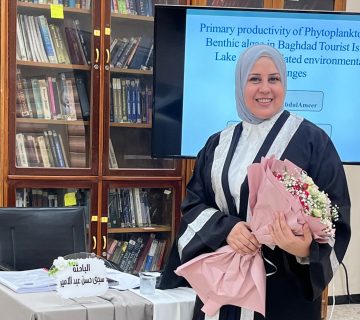Master’s Discussion
College of science for women/University of Baghdad examined the thesis entitled(The assessment of the Asalah area within the Al-Tuwaitha site after decontamination aims to determine the levels of radioactive nuclide contamination and to conduct chemical element analyses in order to estimate potential environmental risks)
of the student: Ola Raied Ali .
The thesis aims to conduct a comprehensive radiological assessment of the decontaminated area in the Al-Tuwaitha site (Asalah area) by measuring the radiation dose rate and background levels at the site, in order to verify the effectiveness of the decontamination processes. A high-purity germanium gamma spectrometer (HPGe) was used to determine the concentrations of radioactive nuclides in soil samples from the Asalah site. In addition, a detailed study was carried out on the structural characteristics of the cleaned soil using XRD, XRF, SEM, and ICP-OES techniques to evaluate the changes in its physical and chemical composition. The RESRAD 7.2 software was employed to estimate the potential post-remediation risks and calculate the long-term health risks resulting from any residual radioactivity. This integrated assessment supports monitoring efforts and ensures that safety levels remain within acceptable limits.
The thesis also included an analysis of soil samples, which showed lower levels of Radium, Actinium, and Potassium, all within international standards and permissible limits. This indicates that the soil is suitable for human use and appropriate for residential purposes. The calculated radiation doses, using the RESRAD software, were found to be below the permissible limit of 1 millisievert per year as defined by safety guidelines.
The study utilized Inductively Coupled Plasma Optical Emission Spectrometry (ICP-OES) for precise measurement of elemental concentrations. The results of X-ray Fluorescence (XRF) analysis indicated the presence of natural radiation sources through chemical element identification. X-ray Diffraction (XRD) analysis revealed the crystalline structure, identifying silica and calcium silicates. Additionally, Scanning Electron Microscopy (SEM) was employed to obtain high-resolution surface images, showing uniform surface morphology with well-defined spacing.
Very Good










